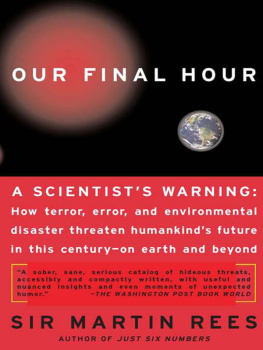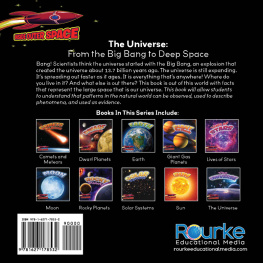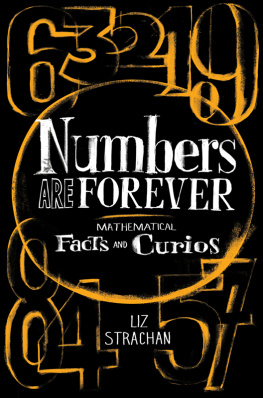Rees - Just Six Numbers: the Deep Forces That Shape The Universe
Here you can read online Rees - Just Six Numbers: the Deep Forces That Shape The Universe full text of the book (entire story) in english for free. Download pdf and epub, get meaning, cover and reviews about this ebook. City: New York, year: 2008, publisher: Basic Books, genre: Children. Description of the work, (preface) as well as reviews are available. Best literature library LitArk.com created for fans of good reading and offers a wide selection of genres:
Romance novel
Science fiction
Adventure
Detective
Science
History
Home and family
Prose
Art
Politics
Computer
Non-fiction
Religion
Business
Children
Humor
Choose a favorite category and find really read worthwhile books. Enjoy immersion in the world of imagination, feel the emotions of the characters or learn something new for yourself, make an fascinating discovery.

Just Six Numbers: the Deep Forces That Shape The Universe: summary, description and annotation
We offer to read an annotation, description, summary or preface (depends on what the author of the book "Just Six Numbers: the Deep Forces That Shape The Universe" wrote himself). If you haven't found the necessary information about the book — write in the comments, we will try to find it.
Just Six Numbers: the Deep Forces That Shape The Universe — read online for free the complete book (whole text) full work
Below is the text of the book, divided by pages. System saving the place of the last page read, allows you to conveniently read the book "Just Six Numbers: the Deep Forces That Shape The Universe" online for free, without having to search again every time where you left off. Put a bookmark, and you can go to the page where you finished reading at any time.
Font size:
Interval:
Bookmark:
JUST SIX NUMBERS
Other books by Martin Rees include
Gravitys Fatal Attraction: Black Holes in the Universe with Mitchell Begelman
Before the Beginning: Our Universe and Others New Perspectives in Astrophysical Cosmology

First published in 1999 in Great Britain
By Weidenfeld & Nicolson
Copyright 2000 by Martin Rees
Published by Basic Books,
A Member of the Perseus Books Group
All rights reserved. No part of this book may be reproduced in any manner whatsoever without written permission except in the case of brief quotations embodied in critical articles and reviews. For information, address Basic Books, 387 Park Avenue South, New York, NY 100168810.
Typeset at The Spartan Press Ltd,
Lymington, Hants
A CIP catalog record for this book is available from the Library of Congress.
ISBN-13: 978-0-786-72358-4
DHSB | 20 19 18 17 16 15 14 |
CONTENTS
Astronomy is the oldest numerical science, crucial in ancient times for calendars and navigation. It is now experiencing a surge of discovery. The enhanced focus on time as we enter the new millennium is boosting interest in our cosmic environment. Astronomy is still the science of numbers, and this book is the story of six that are crucial for our universe, and our place in it.
On the blurred boundaries of ancient maps, cartographers wrote There be dragons. After the pioneer navigators had encircled the globe and delineated the main continents and oceans, later explorers filled in the details. But there was no longer any hope of finding a new continent, or any expectation that the Earths size and shape would ever be drastically reappraised.
At the start of the twenty-first century we have, remarkably, reached the same stage in mapping our universe: the grand outlines are now coming into focus. This is the collective achievement of thousands of astronomers, physicists and engineers, using many different techniques. Modern telescopes probe deep into space; because the light from distant objects takes a long time journeying towards us, they also give us glimpses of the remote past; we have detected fossils laid down in the first few seconds of cosmic history. Spacecraft have revealed neutron stars, black holes, and other extreme phenomena that extend our knowledge of the physical laws. These advances have vastly stretched our cosmic horizons. There has, in parallel, been an exploration of the microworld within the atom, yielding new insights into the nature of space on the tiniest of scales.
The picture that emerges a map in time as well as in space is not what most of us expected. It offers a new perspective on how a single genesis event created billions of galaxies, black holes, stars and planets, and how atoms have been assembled here on Earth, and perhaps on other worlds into living beings intricate enough to ponder their origins. There are deep connections between stars and atoms, between the cosmos and the microworld. This book describes without technicalities the forces that control us and, indeed, our entire universe. Our emergence and survival depend on very special tuning of the cosmos a cosmos that may be even vaster than the universe that we can actually see.
My first debt is to the colleagues with whom I have researched and studied over the years. But Im equally grateful for the penetrating cosmological discussions Ive had with non-specialists: these always bring a fresh perspective, by highlighting the big picture, and reminding me that the most important questions are still unanswered. Special thanks, therefore, to David Hart, Graeme Mitchison, Hans Rausing, and Nick Webb. The present book is intended for general readers of this kind. Ive tried, while avoiding technicalities, to set new discoveries in context, to distinguish well-based claims from speculations, and to emphasize the mysteries that lie beyond.
I thank John Brockman for inviting me to contribute to the Science Masters series, and for his forbearance during the books slow gestation. Toby Mundy and Emma Baxter of Weidenfeld and Nicolson were very supportive throughout the editing and production process. Im grateful to them; also to Richard Sword and Joop Schaye for preparing the illustrations, to Brian Amos for the index, and to Judith Moss for secretarial help.
Man is... related inextricably to all reality, known and unknowable... plankton, a shimmering phosphorescence on the sea and the spinning planets and an expanding universe, all bound together by the elastic string of time. It is advisable to look from the tide pool to the stars and then back to the tide pool again.
John Steinbeck, The Log from the Sea of Cortez
SIX NUMBERS
Mathematical laws underpin the fabric of our universe not just atoms, but galaxies, stars and people. The properties of atoms their sizes and masses, how many different kinds there are, and the forces linking them together determine the chemistry of our everyday world. The very existence of atoms depends on forces and particles deep inside them. The objects that astronomers study planets, stars and galaxies are controlled by the force of gravity. And everything takes place in the arena of an expanding universe, whose properties were imprinted into it at the time of the initial Big Bang.
Science advances by discerning patterns and regularities in nature, so that more and more phenomena can be subsumed into general categories and laws. Theorists aim to encapsulate the essence of the physical laws in a unified set of equations, and a few numbers. There is still some way to go, but progress is remarkable.
This book describes six numbers that now seem especially significant. Two of them relate to the basic forces; two fix the size and overall texture of our universe and determine whether it will continue for ever; and two more fix the properties of space itself:
The cosmos is so vast because there is one crucially important huge number N in nature, equal to 1,000,000, 000,000,000,000,000,000,000,000,000,000. This number measures the strength of the electrical forces that hold atoms together, divided by the force of gravity between them. If N had a few less zeros, only a short-lived miniature universe could exist: no creatures could grow larger than insects, and there would be no time for biological evolution.
Another number, , whose value is 0.007, defines how firmly atomic nuclei bind together and how all the atoms on Earth were made. Its value controls the power from the Sun and, more sensitively, how stars transmute hydrogen into all the atoms of the periodic table. Carbon and oxygen are common, whereas gold and uranium are rare, because of what happens in the stars. If were 0.006 or 0.008, we could not exist.
The cosmic number (omega) measures the amount of material in our universe galaxies, diffuse gas, and dark matter. tells us the relative importance of gravity and expansion energy in the universe. If this ratio were too high relative to a particular critical value, the universe would have collapsed long ago; had it been too low, no galaxies or stars would have formed. The initial expansion speed seems to have been finely tuned.
Measuring the fourth number, (lambda), was the biggest scientific news of 1998. An unsuspected new force a cosmic antigravity controls the expansion of our universe, even though it has no discernible effect on scales less than a billion light-years. It is destined to become ever more dominant over gravity and other forces as our universe becomes ever darker and emptier. Fortunately for us (and very surprisingly to theorists), is very small. Otherwise its effect would have stopped galaxies and stars from forming, and cosmic evolution would have been stifled before it could even begin.
Next pageFont size:
Interval:
Bookmark:
Similar books «Just Six Numbers: the Deep Forces That Shape The Universe»
Look at similar books to Just Six Numbers: the Deep Forces That Shape The Universe. We have selected literature similar in name and meaning in the hope of providing readers with more options to find new, interesting, not yet read works.
Discussion, reviews of the book Just Six Numbers: the Deep Forces That Shape The Universe and just readers' own opinions. Leave your comments, write what you think about the work, its meaning or the main characters. Specify what exactly you liked and what you didn't like, and why you think so.












